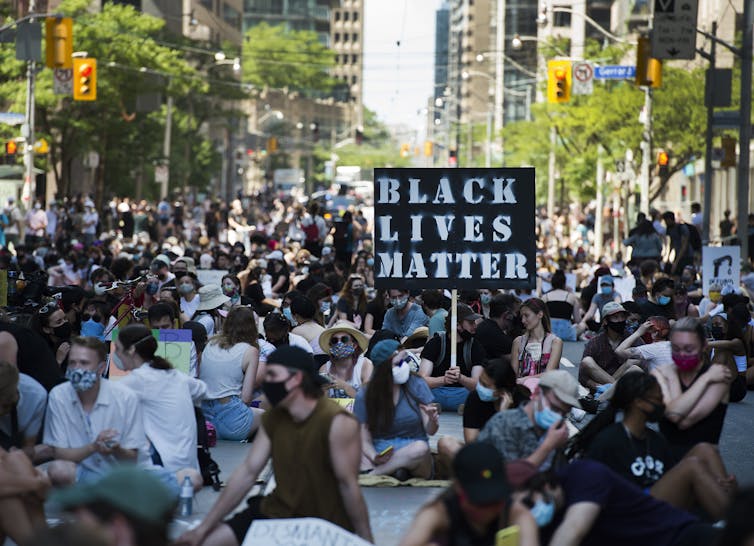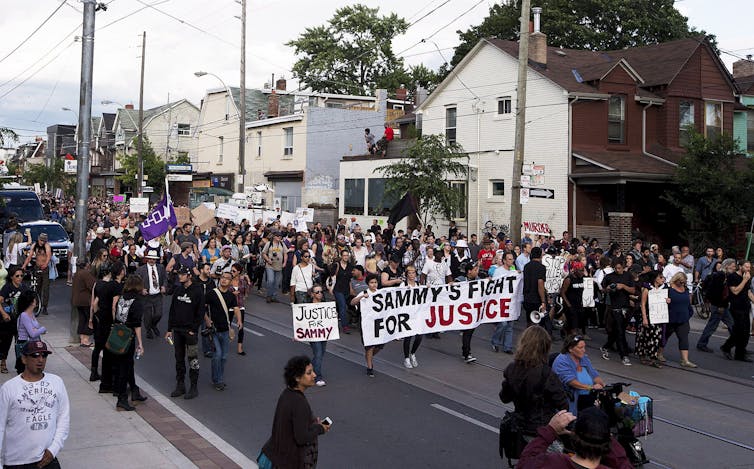
The newly released findings on race-based data of the Toronto Police Service offers another grim reminder of the realities of law enforcement in Canada. The 119-page document, titled Race & Identity Based Data Collection Strategy Understanding: Use of Force & Strip Searches in 2020, explores 7,114 strip searches and 949 incidents involving use of force.
The report finds that Black, Indigenous and racialized people were over-represented in “enforcement actions” by police. For example, although Black people made up 10 per cent of Toronto’s population, they comprised 22.6 per cent of law enforcement actions such as arrests, tickets and cautions.
There is a disproportionate impact of use of force on various minority groups — Black, Latino, East/Southeast Asian and Middle Eastern people were reportedly over-represented by factors of 1.6 times, 1.5 times, 1.2 times and 1.2 times, respectively. Minorities were also more likely to have weapons drawn against them by police.
These findings are familiar, yet deeply troubling. There have been years of community consultations, “reforms,” cultural sensitivity, anti-bias training and diversity and inclusivity policies and programs. But the problem of police using disproportional force has refused to go away.
These findings are not organizational accidents — they reflect conscious and unconscious decisions to use force when dealing with certain sectors of the population.
Insults and apologies
James Ramer, the interim Toronto Police chief, offered an apology on June 15: “As an organization, we have not done enough to ensure that every person in our city receives fair and unbiased policing.… As chief of police and on behalf of the police, I am sorry and I apologize unreservedly.”
However, activists and Toronto minority leaders are understandably frustrated. Beverly Bain, from the No Pride in Policing Coalition, refused to accept the chief’s apology: “What we have asked for you to do is stop. To stop brutalizing us. To stop killing us.” Bain called Ramer’s apology a “public relations stunt,” which she considered “insulting” to those affected.
The apology and its refusal demonstrate the growing gulf between the police and the communities they are sworn to protect. There is no need for them to apologize if they are going to continue to do the exact thing. Apologizing becomes an empty, performative act designed to save face and get though a news conference with limited damage.
Police force
My research team and I began studying police use of force, particularly using conducted energy weapons (CEWs) like Tasers, in the late 2000s. We found that men belonging to ethnic minority groups with a recent immigration history, who suffered from mental health problems or had a history of substance abuse, were over-represented among those who died during or shortly after CEWs were used.
In 2021, I served as the special adviser to the Government of Alberta its Police Act Review. I saw first-hand the frustrations of under-served and over-policed populations during public engagement sessions. Many citizens were tired of being maltreated by those paid to protect them.
Bain’s refusal to accept the chief’s apology also underscores the fact that accountability and responsibility are missing from the report. Who are the officers responsible for these incidents? What disciplinary actions did they face? Are the annual deaths, injuries and psychological damage an acceptable price some segments of society must prepare to bear perpetually? Is there no alternative to this approach to law enforcement?
It is one thing to acknowledge that the police service has a problem, it is another to ensure accountability to ease out perpetrators. Without that, the next report will be identical to the current one. For communities being targeted, that means more traumatized victims, families and friendship circles.

Policing issues
American sociologist Harvey Sacks has argued that, as occupational specialists, police use the “incongruity procedure.” This means they focus on an assessment of who is in place or out of place.
Therefore, being “noticeable” or “visible” is construed as potentially deviant and worthy of attention. This has translated into treating the mere presence of Black or Indigenous people as a problem in and of itself, even when they are merely driving, barbecuing or shopping, among other activities.
Being young is no panacea.
In Canada, children younger than seven years of age have been handcuffed and arrested for throwing tantrums at school. As recently as November of last year, a Kitchener school called police on a four-year-old Black girl.
Recruitment issues
Beyond the police-citizen interactions contributing to these statistics, the persistence of this issue is a manifestation of generations of limited recruitment exercises and an organizational and occupational culture of impunity.
These issues have been the subject of several sociological studies. Research shows that officers who use excessive force make up less than 10 per cent of uniformed police service personnel, and yet the protectionist ring around incorrigible officers is a key problem that remains unaddressed.
Officer misconduct does serious damage to the efforts of the officers who do their jobs fairly and conscientiously.
When incidents of police misconduct are revealed, officers are defended or placed on paid leave. The role of police unions, employment contracts, the famed wall of silence and a hyper-masculinist organizational context is well-documented.

From reports to recommendations
The Toronto Police Service is a leader in producing reports and commissions of inquiries regarding officer misconduct. For example, Justice Frank Iacobucci submitted a report with 84 recommendations in 2014 following the killing of Sammy Yatim on a streetcar by a police officer.
The recommendations include prioritizing the hiring of people with university degrees from disciplines like nursing and social work. Research shows that officers who are overly reliant on force and are prone to deploying excessive force usually have a Grade 12 level education or less.
This is common across scores of police jurisdictions. Such officers also tend to be male. There is a need to dismantle the high school diploma and old boys network core of the police, and hire more women, minorities and people with university degrees.
In addition to leadership committed to change and the elimination of unreasonable contract terms that make accountability improbable, these steps have the potential to improve the organizational culture of police forces.
The use of force report also shows that legislative changes do have an impact. The 2017 Ontario Anti-Racism Act made the collection and release of the report possible. While this is no comfort to those affected, it is a central part of the sober reality regarding police use of force.
The public deserves better, given the share of the common purse spent on policing.
Temitope Oriola received grants from the Social Science and Humanities Research Council (SSHRC) to study the school resource officer program and police use of force in Canada. He is member-at-large of the Alberta Police Misconduct Database Association.
This article was originally published on The Conversation. Read the original article.







